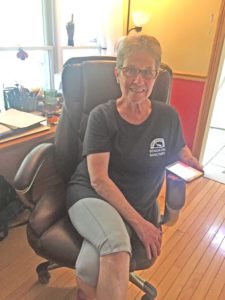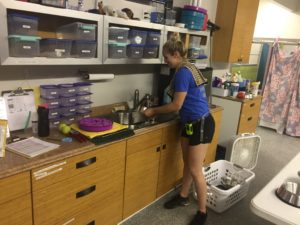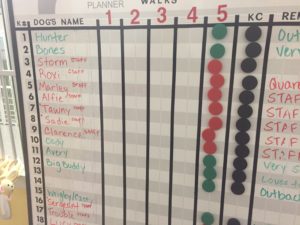Running a Sanctuary like SDS involves all sorts of tasks. Scheduling, personnel, maintenance, fundraising, public outreach… the list goes on. But what is a Sanctuary really for? Why does it exist? To build and maintain a facility? To provide volunteers an opportunity for service? To organize public events? No. Those are important, of course, but they are merely means to an end. A Sanctuary like SDS exists for one reason only: to improve the lives of older dogs. The dogs are the reason for the entire enterprise. Everything else, all the people, equipment, time and effort, are merely resources for promoting the welfare of the dogs, period.
While it should be obvious that “a dog sanctuary is for dogs”, it’s the kind of thing that’s easy to lose track of. When teacher meetings start in a few weeks, I know I’ll be inundated with new procedures, deadlines, and initiatives. It requires a lot of time and energy to deal with the details, and if you’re not careful, it can consume you. You constantly have to remind yourself, why am I here in the first place? Who is this actually for? For a teacher, it’s the students. For a Sanctuary, it’s the dogs. To stay true to your calling, you have to step back, and evaluate every action you take in the light of the only meaningful measuring stick: “Is this good for them? Does it improve their lives?”
It was deeply gratifying to discover that everyone I spoke to at SDS, regardless of their role, never lost sight of the underlying goal, which is taking care of the dogs and finding them homes. Every action and decision is focused on that core ideal. It has shaped all aspects of the facility and organization, from intake and adoption policies, to design of the kennel room and play yard, to outreach and staff training. It’s all for the dogs’ benefit. And staying true to this goal is the reason they have been so successful. They have integrity. New volunteers, adopters, and donors can sense that, and it makes it easy to buy in.

Dogs require a lot of care and attention, and that is especially true of older dogs. Like people, older dogs have more medical issues. They are prone to dental disease, diabetes, arthritis, heart disease, cancer, dementia. To find them homes, many dogs have to be nursed back into an adoptable state. It’s one of the main questions in deciding which dogs to take in to SDS: are they healthy enough to be adopted? If not, can their problems be treated without breaking the bank?
On my visit to SDS, I talked about these and many other issues with Barb Turner, the Shelter Manager. Barb is a retired “human nurse” who literally lives at SDS. They call her the Shelter Mom. While Val looks after the Big Picture at SDS, Barb is in charge of day-to-day operations. She is the type of no-nonsense, get-things-done person that every organization needs. (She was worried I would think she was a crotchety old lady, but I found her to be a hoot!) She works about 16 hours a day, but it fits her personality. “I have no life,” she says, which isn’t true, but does accurately describe her work habits.

As a nurse, Barb is the resident medical expert at SDS. She consults regularly with the veterinarians, and often shadows the vets when they treat her dogs. By asking the vet questions, she can correlate the dog’s medical problems with her knowledge of human medicine. She knows how to read lab results and administer medications (except for a few, like rabies, that can only be given by a vet). She keeps records, creates treatment protocols, and handles medical expenses. Such expertise is indispensible to an organization dealing with the health of older dogs.
Taking care of old dogs is an expensive proposition. Each dog is given a thorough check-up at the vet when they arrive, including shots and vaccines. Females are spayed, if necessary, because they can still get pregnant (though they can’t carry to term), and they are more susceptible to breast cancer if they are not. Most of the dogs have other medical issues which must be treated. SDS works with two vet offices, and transports dogs to the vet on an almost daily basis. Medication costs around $600 a month, prescription food about $1200. Overall, it amounts to a sizable investment in each dog, on the order of $1000 – $3000, with some dogs requiring even more. It is a statistic we will have to weigh carefully as we plan for our own Sanctuary.
As a health food skeptic, I was surprised and properly re-educated about the importance of the dogs’ diet. SDS does not use any “grocery store” dog food (though they gladly accept donations, which they funnel to other needy shelters). With old dogs, you need food that will maximize their health, reduce joint aches, keep them at a healthy weight, and prevent diarrhea. They have found that Hill’s Science Diet and other prescription dog foods will cut diarrhea by 85%. (Bet you wanted to know that!) Barb also prepares a lot of chicken and rice for the dogs.
After talking to Barb, I spent some time tagging along with Valerie (sorry, I didn’t write down her last name), one of the kennel technicians. Valerie is a college student home for the summer, and she worked as a volunteer in the past. She showed me how they prepare the dogs’ food, how they leash and walk them, how they clean the kennels, wash the dogs, watch for developing health issues, and so on. I got to walk one of the dogs, which is like spiritual comfort food to me.

Each dog is walked at least five times a day. Some of the dogs can only be walked by staff, usually because of medical issues. Monday is “Weight Day”, when all the dogs get weighed. Wednesday is “Ear Day”, in which each dog has its ears cleaned and checked for pests. Friday is “Wishy Washy Day”, when they all get a bath. The play yard has “doggie astroturf”, which prevents insects such as ticks and fleas, and is more easily cleaned than grass. All of the dog-handling areas were very clean and well-organized.
Like the volunteers, the Staff at SDS has been empowered to think creatively. They are encouraged to find new ways to constantly improve the quality of care. They came up with the information boards, the weekly schedule, and feeding and walking procedures. They are free to come up with and propose new solutions.

I am not a Vet, or a Vet Tech. I’m not even a well-versed amateur (yet) when it comes to animal health. Turns out we feed our dogs crappy food, and we don’t clip their nails often enough. But I at least now know what I don’t know, if that makes sense. A Sanctuary’s sole purpose is to promote the well being of its dogs, and to do that, you need people with the expertise to take care of them. You also need the financial resources it requires. The SDS has done a fabulous job of both. Its heart and soul are focused on the dogs, and its purity of purpose attracts those who share that vision. It is a model we hope to emulate.
